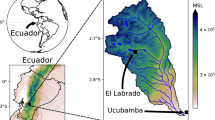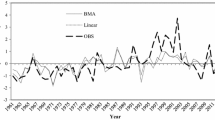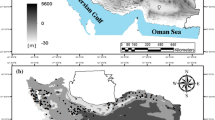Abstract
Selection of potential causal variables (PCVs) from a pool of many possibly associated variables is a critical issue since it can significantly affect the performance of any statistical downscaling model. Generally, the variable to be downscaled is associated with many other hydrologic and climatic (aka hydroclimatic) variables. Most of the existing approaches, such as correlation analysis (CA), partial correlation analysis (PaCA), and stepwise regression analysis (SRA), rely mostly on the mutual association for the selection of PCVs. However, none of these approaches investigate the detailed dependence structure that may be helpful in eliminating the unwanted information and efficiently selecting the PCVs for downscaling the target variable. In this study, the effectiveness of graphical modeling (GM) approach is explored for the selection of the PCVs as GM can effectively identify the detailed conditional independence structure among all the associated variables. For demonstration, downscaling of monthly precipitation is undertaken using the PCVs, identified by CA, PaCA, SRA, and the proposed GM approach. Two different downscaling models, namely statistical downscaling model (SDSM) and support vector regression (SVR)–based downscaling model, are utilized. The results show that the PCVs identified through the proposed GM approach provides consistent as well as robust performance, across different regions and seasons, due to its ability to capture the complete conditional indepedence structure among the variables. The downscaled monthly precipitation obtained using the proposed approach is better matching with the observed data in terms of the mean, variance as well as the probability distribution. Overall, this study recommends the GM approach for the identification of the PCVs for the downscaling models.







Similar content being viewed by others
References
Anandhi A, Srinivas VV, Nanjundiah RS, Nagesh Kumar D (2008) Downscaling precipitation to river basin in India for IPCC SRES scenarios using support vector machine. Int J Climatol 28:401–420. https://doi.org/10.1002/joc.1529
Bang-Jensen J, Gutin G (2007) Digraphs: theory, algorithms and applications. Softw Testing, Verif Reliab 12:59–60. https://doi.org/10.1002/stvr.240
Bates BC, Charles SP, Hughes JP (1998) Stochastic downscaling of numerical climate model simulations. Environ Model Softw 13:325–331. https://doi.org/10.1016/S1364-8152(98)00037-1
Beal MJ, Jojic N, Attias H (2003) A graphical model for audiovisual object tracking. IEEE Trans Pattern Anal Mach Intell 25:828–836. https://doi.org/10.1109/TPAMI.2003.1206512
Bergströms, Carlsson B, Gardelin M et al (2001) Climate change impacts on runoff in Sweden-assessments by global climate models, dynamical downscalling and hydrological modelling. Clim Res 16:101–112. https://doi.org/10.3354/cr016101
Beuchat X, Schaefli B, Soutter M, Mermoud A (2012) A robust framework for probabilistic precipitations downscaling from an ensemble of climate predictions applied to Switzerland. J Geophys Res Atmos 117:1–16. https://doi.org/10.1029/2011JD016449
Box GE, Cox DR (1964) An analysis of transformations. J R Stat Soc 26:211–252
Cavazos T, Hewitson BC (2005) Performance of NCEP-NCAR reanalysis variables in statistical downscaling of daily precipitation. Clim Res 28:95–107
Charles SP, Bates BC, Whetton PH, Hughes JP (1999) Validation of downscaling models for changed climate conditions: case study of southwestern Australia. Clim Res 12:1–14. https://doi.org/10.3354/cr012001
Chen ST, Yu PS, Tang YH (2010) Statistical downscaling of daily precipitation using support vector machines and multivariate analysis. J Hydrol 385:13–22. https://doi.org/10.1016/j.jhydrol.2010.01.021
Chen J, Brissette FP, Leconte R (2011) Uncertainty of downscaling method in quantifying the impact of climate change on hydrology. J Hydrol 401:190–202. https://doi.org/10.1016/j.jhydrol.2011.02.020
Chen H, Xu CY, Guo S (2012) Comparison and evaluation of multiple GCMs, statistical downscaling and hydrological models in the study of climate change impacts on runoff. J Hydrol 434–435:36–45. https://doi.org/10.1016/j.jhydrol.2012.02.040
Chithra NR, Thampi SG (2017) Downscaling future projections of monthly precipitation in a catchment with varying physiography. ISH J Hydraul Eng 23:144–156. https://doi.org/10.1080/09715010.2016.1264895
Coulibaly P, Baldwin CK (2005) Nonstationary hydrological time series forecasting using nonlinear dynamic methods. J Hydrol 307:164–174. https://doi.org/10.1016/j.jhydrol.2004.10.008
Dettinger MD, Cayan DR, Meyer MK, Jeton A (2004) Simulated hydrologic responses to climate variations and change in the Merced, Carson, and American River basins, Sierra Nevada, California, 1900-2099 *. Clim Change 62:283–317. https://doi.org/10.1023/B:CLIM.0000013683.13346.4f
Devak M, Dhanya CT (2014) Downscaling of precipitation in Mahanadi Basin, India. Int J Civ Eng Res 5:111–120
Dutta R, Maity R (2018) Temporal evolution of hydroclimatic teleconnection and a time-varying model for long-lead prediction of Indian summer monsoon rainfall. Sci Rep 8:10778. https://doi.org/10.1038/s41598-018-28972-z
Dutta R, Maity R (2020a) Spatial variation in long‐lead predictability of summer monsoon rainfall using a time‐varying model and global climatic indices. Int J Climatol. https://doi.org/10.1002/joc.6556
Dutta R, Maity R (2020b) Temporal networks‐based approach for nonstationary hydroclimatic modeling and its demonstration with streamflow prediction. Water Resour Res 56:e2020WR027086. https://doi.org/10.1029/2020WR027086
Fowler HJ, Blenkinsop S, Tebaldi C (2007) Linking climate change modelling to impacts studies: recent advances in downscaling techniques for hydrological modelling. Int J Climatol 27:1547–1578. https://doi.org/10.1002/joc.1556
Grimes DIF, Coppola E, Verdecchia M, Visconti G (2003) A neural network approach to real-time rainfall estimation for Africa using satellite data. J Hydrometeorol 4:1119–1133. https://doi.org/10.1175/1525-7541(2003)004<1119:ANNATR>2.0.CO;2
Gutmann E, Pruitt T, Clark M (2014) An intercomparison of statistical downscaling methods used for water resource assessments in the United States. Water Resour Res:1–20. https://doi.org/10.1002/2014WR015559.Received
Harpham C, Wilby RL (2005) Multi-site downscaling of heavy daily precipitation occurrence and amounts. J Hydrol 312:235–255. https://doi.org/10.1016/j.jhydrol.2005.02.020
Hassan Z, Shamsudin S, Harun S (2014) Application of SDSM and LARS-WG for simulating and downscaling of rainfall and temperature. Theor Appl Climatol 116:243–257. https://doi.org/10.1007/s00704-013-0951-8
Haylock MR, Cawley GC, Harpham C, Wilby RL, Goodess CM (2006) Downscaling heavy precipitation over the United Kingdom: a comparison of dynamical and statistical methods and their future scenarios. Int J Climatol 26:1397–1415. https://doi.org/10.1002/joc.1318
Hessami M, Gachon P, Ouarda TBMJ, St-Hilaire A (2008) Automated regression-based statistical downscaling tool. Environ Model Softw 23:813–834. https://doi.org/10.1016/j.envsoft.2007.10.004
Huth R (1999) Statistical downscaling in central Europe: evaluation of methods and potential predictors. Clim Res 13:91–101. https://doi.org/10.3354/cr013091
Ihler AT, Kirshner S, Ghil M, Robertson AW, Smyth P (2007) Graphical models for statistical inference and data assimilation. Phys D Nonlinear Phenom 230:72–87. https://doi.org/10.1016/j.physd.2006.08.023
Johnson AR, Bhattacharya KG (2009) Statistics: principles and methods, sixth. John Wiley & Sons, Inc., United States of America
Jordan MI (2004) Graphical Models. Stat Sci 19:140–155. https://doi.org/10.1214/088342304000000026
Kidson JW, Thompson CS (1998) A comparison of statistical and model-based downscaling techniques for estimating local climate variations. J Clim 11:735–753. https://doi.org/10.1175/1520-0442(1998)011<0735:ACOSAM>2.0.CO;2
Krumsiek J, Suhre K, Illig T, Adamski J, Theis FJ (2011) Gaussian graphical modeling reconstructs pathway reactions from high-throughput metabolomics data. BMC Syst Biol 5:21. https://doi.org/10.1186/1752-0509-5-21
Lauritzen SL, Sheehan NA (2003) Graphical models for genetic analyses. Stat Sci 18:489–514. https://doi.org/10.1214/ss/1081443232
Liu Z, Xu Z, Charles SP, Fu G, Liu L (2011) Evaluation of two statistical downscaling models for daily precipitation over an arid basin in China. Int J Climatol 31:2006–2020. https://doi.org/10.1002/joc.2211
Maity R (2018) Statistical methods in hydrology and hydroclimatology. Springer Nature, Singapore
Meenu R, Rehana S, Mujumdar PP (2013) Assessment of hydrologic impacts of climate change in Tunga-Bhadra river basin, India with HEC-HMS and SDSM. Hydrol Process 27:1572–1589. https://doi.org/10.1002/hyp.9220
Okkan U, Inan G (2015) Statistical downscaling of monthly reservoir inflows for Kemer watershed in Turkey: use of machine learning methods, multiple GCMs and emission scenarios. Int J Climatol 35:3274–3295. https://doi.org/10.1002/joc.4206
Pervez MS, Henebry GM (2014) Projections of the Ganges-Brahmaputra precipitation-downscaled from GCM predictors. J Hydrol 517:120–134. https://doi.org/10.1016/j.jhydrol.2014.05.016
Pichuka S, Maity R (2016) Spatio-temporal downscaling of projected precipitation in the 21st century: indication of a wetter monsoon over the Upper Mahanadi Basin, India. Hydrol Sci J 62:1–16. https://doi.org/10.1080/02626667.2016.1241882
Pierce DW, Cayan DR, Thrasher BL (2014) Statistical downscaling using localized constructed analogs (LOCA)*. J Hydrometeorol 15:2558–2585. https://doi.org/10.1175/JHM-D-14-0082.1
Pinto JG, Neuhaus CP, Leckebusch GC, Reyers M, Kerschgens M (2010) Estimation of wind storm impacts over Western Germany under future climate conditions using a statistical-dynamical downscaling approach. Tellus, Ser A Dyn Meteorol Oceanogr 62:188–201. https://doi.org/10.1111/j.1600-0870.2009.00424.x
Radchenko P, James GM (2010) Variable selection using adaptive nonlinear interaction structures in high dimensions. J Am Stat Assoc 105:1541–1553. https://doi.org/10.1198/jasa.2010.tm10130
Schoof JT, Shin DW, Cocke S, LaRow TE, Lim YK, O'Brien JJ (2009) Dynamically and statistically downscaled seasonal temperature and precipitation hindcast ensembles for the southeastern USA. Int J Climatol 29:243–257. https://doi.org/10.1002/joc.1717
Semenov MA, Brooks RJ, Barrow EM, Richardson CW (1998) Comparison of the WGEN and LARS-WG stochastic weather generators for diverse climates. Clim Res 10:95–107. https://doi.org/10.3354/cr010095
Stoner AMK, Hayhoe K, Yang X, Wuebbles DJ (2013) An asynchronous regional regression model for statistical downscaling of daily climate variables. Int J Climatol 33:2473–2494. https://doi.org/10.1002/joc.3603
Taeb A, Reager JT, Turmon M, Chandrasekaran V (2017) A statistical graphical model of the California Reservoir System. Water Resour Res. 53:9721–9739. https://doi.org/10.1002/2017WR020412
Tatli H, Dalfes HN, Menteş ŞS (2004) A statistical downscaling method for monthly total precipitation over Turkey. Int J Climatol 24:161–180. https://doi.org/10.1002/joc.997
Tatsumi K, Oizumi T, Yamashiki Y (2015) Effects of climate change on daily minimum and maximum temperatures and cloudiness in the Shikoku region: a statistical downscaling model approach. Theor Appl Climatol 120:87–98. https://doi.org/10.1007/s00704-014-1152-9
Tomozeiu R, Cacciamani C, Pavan V, Morgillo A, Busuioc A (2007) Climate change scenarios for surface temperature in Emilia-Romagna (Italy) obtained using statistical downscaling models. Theor Appl Climatol 90:25–47. https://doi.org/10.1007/s00704-006-0275-z
Webster PJ, Magaña VO, Palmer TN, Shukla J, Tomas RA, Yanai M, Yasunari T (1998) Monsoons: processes, predictability, and the prospects for prediction. J Geophys Res Ocean 103:14451–14510. https://doi.org/10.1029/97JC02719
Whittaker J (2009) Graphical models in applied multivariate statistics. Wiley Publishing
Wilby RL, Hay LE, Leavesly HH (1999) A comparison of downscaled and raw output: implications for climate change scenarios in the San Juan river basin, Colorado. J Hydrol 225:67–91. https://doi.org/10.1016/S0022-1694(99)00136-5
Wilby R, Dawson C, Barrow E (2002) Sdsm—a decision support tool for the assessment of regional climate change impacts. Environ Model Softw 17:145–157. https://doi.org/10.1016/S1364-8152(01)00060-3
Wood AW, Leung LR, Sridhar V, Lettenmaier DP (2004) Hydrologic implications of dynamical and statistical approaches to downscaling climate model outputs. Clim Change 62:189–216. https://doi.org/10.1023/B:CLIM.0000013685.99609.9e
Yang J, Li L, Wang A (2011) A partial correlation-based Bayesian network structure learning algorithm under linear SEM. Knowledge-Based Syst 24:963–976. https://doi.org/10.1016/j.knosys.2011.04.005
Yang C, Wang N, Wang S, Zhou L (2016) Performance comparison of three predictor selection methods for statistical downscaling of daily precipitation. Theor Appl Climatol 131:43–54. https://doi.org/10.1007/s00704-016-1956-x
Yang C, Wang N, Wang S (2017) A comparison of three predictor selection methods for statistical downscaling. Int J Climatol 37:1238–1249. https://doi.org/10.1002/joc.4772
Zuo D, Xu Z, Zhao J, Abbaspour KC, Yang H (2015) Response of runoff to climate change in the Wei River basin, China. Hydrol Sci J 60:508–522. https://doi.org/10.1080/02626667.2014.943668
Funding
The work was partially supported by the sponsored projects supported by Department of Science and Technology, Climate Change Programme (SPLICE), Government of India (Ref No. DST/CCP/CoE/79/2017(G)), through a sponsored project.
Author information
Authors and Affiliations
Corresponding author
Additional information
Publisher’s note
Springer Nature remains neutral with regard to jurisdictional claims in published maps and institutional affiliations.
Appendix 1. Mathematical details of correlation analysis, partial correlation analysis, and stepwise regression analysis
Appendix 1. Mathematical details of correlation analysis, partial correlation analysis, and stepwise regression analysis
1.1 Appendix 1.1. Correlation analysis
The correlation analysis (CA) is the most commonly used approach for selection of the PCVs. Strong correlation of the causal variables, from a pool of possibly associated hydroclimatic variables, with the target variable is the most basic criteria for selection of PCVs. In this approach, the selection is governed by the correlation coefficient between the associated variables and the target variable to be downscaled. A certain value of the correlation coefficient is considered the threshold value and all the associated variables having equal or higher correlation are considered the PCVs for downscaling. Pearson’s correlation coefficient is used in this study and the same can be expressed as follows,
where rxy is Pearson’s correlation coefficient between the associated variables (X) and predictand (Y), n is the number of observations, xi and yi are the observations of X and Y respectively, and \( \overline{x} \) and \( \overline{y} \)are the means of X and Y respectively. The p value is evaluated, considering the correlation coefficient to follow t distribution at 95 % confidence level with n − 2 degrees of freedom. The causal variables with p value greater than 0.05 are recommended to select as the PCVs of the statistical downscaling model.
1.2 Appendix 1.2. Partial correlation analysis
Partial correlation is the measure of association between two variables (a particular associated variable and target variable), while controlling the effect of other associated variables. The partial correlation analysis (PaCA) can be used to identify the PCVs for downscaling as it adjusts the effect of other associated variables. The partial correlation coefficient between two variables controlling the third variable can be expressed as follows,
where rxy, z is the partial correlation between two variables X and Y when the third variable Z is controlled and rxy, rxz, ryz is the correlation coefficient between X and Y, X and Z, and Y and Z respectively. The p value is evaluated, considering the partial correlation coefficient to follow t distribution at 95% confidence level with n − 3 degrees of freedom. The causal variables with p value greater than 0.05 are recommended to select as the PCVs of the statistical downscaling model.
1.3 Appendix 1.3. Stepwise regression analysis
The stepwise regression analysis (SRA) is a method of fitting a regression model by stepwise removal of the least significant variables until all the remaining variables are significant. This method is often used for selection of PCVs when a large number of associated variables are available and to deal with issues related to multi-collinearity. In this technique, initially all the causal variables are considered in the model. At each step of the analysis, a variable is included or excluded from the model usually based on the partial F-tests. If F is greater than the critical F value, the causal variables can be included in the equation. The partial F statistic can be expressed as follows,
where R is the correlation coefficient between a criteria variable and prediction equation, q is the number of causal variables in the equation, and n is as defined before. If the test statistic is less than the critical F value at 95% confidence level with degree of freedom (n − q − 1), the causal variables should be excluded from the equation. The causal variables with p value greater than 0.05 are recommended to select as the PCVs of the statistical downscaling model.
Rights and permissions
About this article
Cite this article
Dutta, R., Maity, R. Identification of potential causal variables for statistical downscaling models: effectiveness of graphical modeling approach. Theor Appl Climatol 142, 1255–1269 (2020). https://doi.org/10.1007/s00704-020-03372-4
Received:
Accepted:
Published:
Issue Date:
DOI: https://doi.org/10.1007/s00704-020-03372-4




